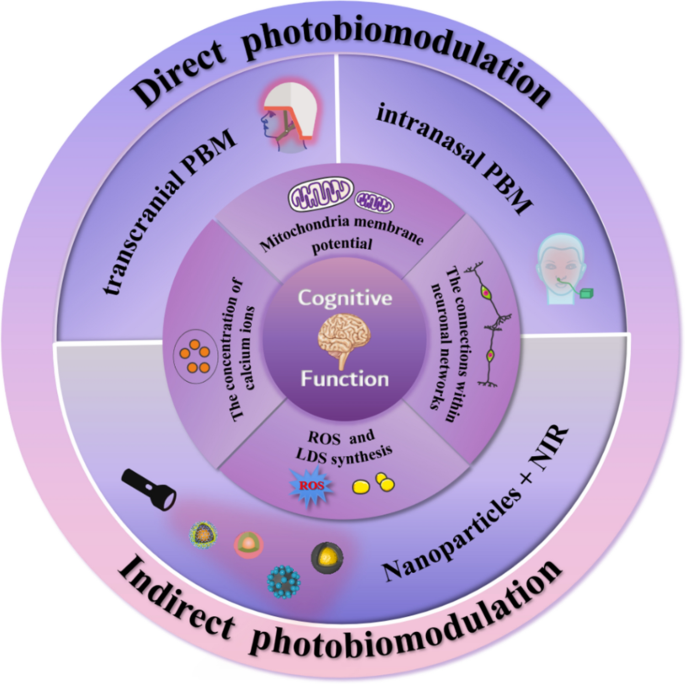8 Simple Techniques For Photobiomodulation
Wiki Article
The 10-Second Trick For Photobiomodulation
Table of ContentsThe Only Guide to PhotobiomodulationPhotobiomodulation Fundamentals ExplainedOur Photobiomodulation PDFsThe Ultimate Guide To Photobiomodulation
Laser therapy is a medical treatment that makes use of focused light to promote a process called. During PBM, photons get in the tissue and connect with the cytochrome c complicated within mitochondria. This interaction sets off an organic waterfall of occasions that causes a boost in mobile metabolic rate, which can along with increase the healing procedure.There is agreement that the application of a restorative dosage of light to damaged or dysfunctional tissue brings about a mobile response mediated by mitochondrial systems. Photobiomodulation. Researches have actually shown that these adjustments can influence pain and swelling, as well as, tissue fixing
Changes in ATP, reactive oxygen varieties and nitric oxide follow light absorption by Cc, O. These effects are redox state and dose reliant. In hypoxic or otherwise stressed cells it has actually been revealed sometimes that following, nitric oxide is launched, ATP is increased and oxidative tension is lowered [27-31]

See This Report about Photobiomodulation
PBM gadgets have been gotten rid of for advertising and marketing by FDA via the Premarket Notification/510( k) process as adjunctive tools for the short-lived alleviation of discomfort. These clearances were based upon the presentation of scientific data to sustain such cases (Photobiomodulation). In this therapy, a light source is put near or in contact with the skin, permitting the light energy (photons) to penetrate cells where it communicates with chromophores found in cells resulting in photophysical and photochemical changes that cause alterations at the molecular, mobile and tissue degrees of the bodySurprisingly, recent study suggests that light can boost performance in typical cells and cells. The possible applications of PBMT are various and are being discovered experimentally at the basic science, pre-clinical and professional degree. The existing clinical uses are for the alleviation of pain and swelling and the therapy of sports injuries.

The treatment specifications and number of sessions required find more information for PBMT depend on location and reason. PBMT typically requires greater than one therapy for optimum discomfort relief. It might take a number of treatments for the results to end up being obvious. records that it can take anywhere from eight to 30 sessions for find out this here a therapy to be totally reliable, and some clients discover it essential to undergo treatment 2 to 4 times weekly.
The 9-Minute Rule for Photobiomodulation
Treatment criteria for PBMT were initially established using cells in vitro and in tiny pet models. These therapy parameters usually had a low irradiance and fluence and worked well for cutaneous applications. When clinicians began to use PBMT to deal with structures that were located much deeper in the body, they made use of these parameters with unfavorable results.
We currently comprehend that these negative studies was because of inaccurate gadget and treatment criteria for transcutaneous therapy of much deeper frameworks. Current breakthroughs in laser therapy devices and more research right into the ideal dosages have actually considerably enhanced the results of PBMT. For dealing with deep cells, the wavelength of light made use of establishes the deepness of infiltration into a cells.
It is crucial that a clinician uses the ideal wavelength of light and specifications to treat a problem. One wavelength and one set of treatment parameters will certainly not be effective for all problems. Negative side effects have actually not been reported resource from the use of PBMT.
The 5-Second Trick For Photobiomodulation
In the first experiment, Dr. Endre Mester, made use of cut rats and observing how the laser impacted their ability to expand hair contrasted to the team that was not receiving LLLT. He discovered that the group of mice getting LLLT had the ability to expand their hair back more swiftly than the team of computer mice that didn't receive LLLT (Hoon C, et al; 2012).This treatment is termed this method to separate the difference between the lasers some professions use to reduce (eg. Low-level light treatment is pain-free, non-invasive therapy.
LLLT has a biphasic reaction, implying that reduced doses are generally attended be a lot more beneficial than greater doses. That being said, doses greater or less than the optimal dose does not influence (Hoon C, et alia; 2012). For this reason, it can be hard to have researches on LLLT with many criteria.
Some firms combined both (LED and laser) to give a much more all-around treatment because lasers can penetrate deeper than LED and infrared light (Norman Doidge, The Mind's Method of Recovery, 2015). Throughout treatment, the location that is being dealt with is exposed to LED light from a Bio, Flex Laser, which goes to 660 nm wavelength, adhered to by infrared light at 830-840 nm wavelength.
Report this wiki page